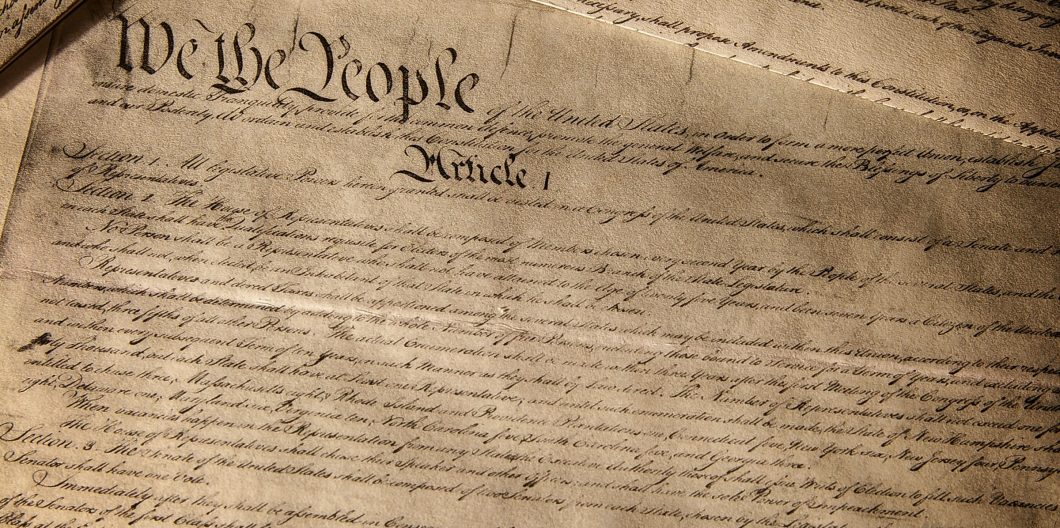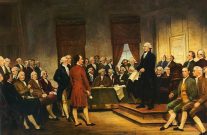What Did the Three-Fifths Clause Really Mean?
The Constitution’s Three-Fifths Compromise, which counted three-fifths of a state’s slave population for purposes of taxation and the apportionment of representatives and presidential electors, was repealed by the Reconstruction Amendments over 160 years ago. Yet it still stirs strong political passions that are unfortunately not matched by knowledge of its genesis, content, or effects.
A few weeks ago, Justin Lafferty, a member of the Tennessee House of Representative, stated that the three-fifths compromise was part of an abolitionist movement to end slavery. Other commentators have denounced the compromise, arguing instead that it was wrong because it denigrated slaves as three-fifths of a person. Both perspectives illustrate the distortions that inevitably occur when history becomes a casualty of our culture wars.
The three-fifths compromise reveals the intricacies of history and the care necessary when critiquing the actions of our forebears. Correctly understood, it reveals that historical events are themselves dependent on their own past and have unforeseen future consequences. And it also shows the importance of considering history counterfactually: there is indeed an argument that the three-fifths compromise ultimately helped end slavery, even if had nothing to do with the abolition movement, because the compromise was necessary to the creation of the union. History can ask normative questions, but only if it is not turned into a simple-minded morality play, where it is assumed that even the best of actors of the past acted only under our current constraints.
The Three-Fifths Clause and the Constitutional Baseline
The Clause provided:
Representatives and direct Taxes shall be apportioned among the several States which may be included within this Union, according to their respective Numbers, which shall be determined by adding to the whole Number of free Persons, including those bound to Service for a Term of Years, and excluding Indians not taxed, three fifths of all other Persons
Note that the text of the Clause is itself complex. On the one hand, it gave the southern states more representatives than if only free persons were counted, but it also made them liable for more direct taxes which are proportioned according to representation. These states must take the bitter as well as the sweet. Moreover, the Clause consciously avoids mentioning slavery. This omission increasingly annoyed southern states, which dared to celebrate the institution when they wrote the Confederate Constitution.
But most importantly, understanding its text on representation dispels a misconception. It would have been worse for the opponents of slavery if slaves had been counted fully in the enumeration. A full count would have yielded slave-holding states more members in Congress and more presidential electoral votes. The great evil at the time of the Constitution was slavery itself and the inextricably linked fact that slaves did not have the franchise. The three-fifths clause added to this wrong by giving the southern states more power than if slaves had not been counted at all, but the discounting the enslaved population reduced the power of these states compared to full counting.
The harder question is whether this perspective furnishes the right baseline. Did the three-fifths compromise replace a result that would have been worse for ending slavery? This question forces us to consider how such an unusual fraction of three-fifths came to be included in the Constitution.
The first time that three-fifths appears was in an attempt to amend the Articles of Confederation, which regulated the relations among the states before the Constitution. The states had trouble raising money and some representatives, including James Madison, tried to create more authority in the continental Congress to impose taxes. The three-fifths provision in that amendment formulated an apportionment among the states for taxes. Slaves were an important source of wealth and thus the view was that some portion of that productive power should be included in the proportion of taxable economic activity. The reason that slaves were not fully counted for the purpose of taxation provides a window into one of the many evils of slavery: Self-ownership is far more conductive to productivity than slavery. The amendment was defeated for other reasons, but the principle of including a discounted proportion remained available for future use.
The consequences of the compromise underscore a historical reality that should be emphasized in every history course: decisions have profound results that no one intended at the time.
At the Philadelphia Convention, James Wilson of Pennsylvania, one of the most important architects of the Constitution, proposed that the proportion be used as a basis of apportionment. Charles Pinckney of South Carolina seconded the motion. Thus, its genesis shows it was a compromise with an opponent of slavery joining a defender to propose it. Abolition was not a possible proposal if the Constitution were to be ratified. As William Ewald, a professor at the University of Pennsylvania Law School and biographer of Wilson puts it, “the Convention would have come to a rapid end if [Wilson] had pushed for abolition.”
The Convention then defeated a proposal put forward by southern delegates to count the slaves fully for the purpose of apportionment. This motion reveals a kernel of truth in the Tennessee Representative’s position: The three-fifths proposal prevailed over one that would have given more power to the southern states.
The Compromise and Its Consequences
Wilson knew better than we do what deals had to be done for the union to be founded. To think otherwise is to engage in a kind of condescension toward the past. The greatest statesmen of any era understand the constraints under which they operate. Sadly, there was no way the Constitution could both have abolished slavery and created a union of the thirteen states.
We can consider whether it would have been better, in principle, not to have created the union at all—not to have made these compromises—by looking at future history counterfactually in a way that the Founders could not do.
If the northern and southern states had not been able to forge a union because of a failure to compromise, the most likely alternative would have been two regional compacts that resembled the Constitution in giving stronger powers than those of the Articles of Confederation to a central government. As Akhil Amar has explained, there was a geopolitical necessity to such a strengthening of government. The states needed a more effective constitutive mechanism to defend themselves against foreign powers.
But sectional compacts would have entrenched slavery for much longer. The South would not have faced the abolitionist pressures from the North. And of course, they would not have seceded from the larger union, triggering the civil war that ended slavery. More subtly, the Constitution’s creation of a commercial republic engendered a political climate that valorized free labor—an ideal that was in fundamental tension with slavery.
Another irony of the three-fifths clause is that it made possible Jefferson’s election—the so-called Revolution of 1800. That consequence was widely understood at the time when the extra electoral votes that he gained as a result of the three-fifths clause were termed the “slave power,” by those most opposed to slavery in the North. John Adams would have triumphed if the Southern states had not been able to count their enslaved populations, even at discounted rates.
While I am not by any means a partisan of Jefferson, the general view is that his victory in 1800 was one for democracy over elitism, for freedom (for those who were not slaves—and it should be noted that abolition was not yet part of the national political debate) over the tyrannical Alien and Sedition Acts. It probably also was essential to the Louisiana purchase that was the first step to the United States becoming a continental power, both because Jefferson was a more flexible negotiator than Adams and because as President, he was willing to put aside constitutional scruples over the federal authority to do so that his party would have strongly pressed had it been in opposition.
Thus, the unintended consequences of the three-fifths compromise democratized the nation’s political culture and expanded its boundaries. This sequence of events underscores a historical reality that should be emphasized in every history course: decisions have profound results that no one intended at the time. Like the effect of the three-fifths compromise on slavery, it is more proof of Kant’s dictum that “out of the crooked timber of humanity no straight thing was ever made.”
The Danger of Critical Race Theory
Rep. Lafferty’s remarks came in an attack on critical race theory. Supporters of that theory seized on his error to suggest that they showed why critical race theory is needed. But the incident shows nothing of the kind. First, his critics often got their understanding of the three-fifths compromise wrong, not recognizing that fully counting the slaves would have been worse for the cause of ending slavery. Second, while Lafferty was not correct in connecting the clause with abolitionism, the three-fifths compromise was likely one of the compromises needed to create the union, which likely ended slavery faster than the plausible alternatives. Critical race theory, which sees American history as a simple tale of racial subordination, would suppress such analysis. Third, even the three-fifths compromise is far more complex in its effects than can be captured through the prism of race. Critical race theory, like Marxist theories of history, is terribly reductionist. Party lines in history always lead to a flattening of a past’s many dimensions.
Rejecting history as a species of agitprop does not mean we must suspend all moral judgments. Evaluating the historic events of our nation is necessary for the continuity of a community like ours, which depends upon a relation to a shared past. But these judgments also depend on an imaginative sympathy with our forebears and an ability to project ourselves into a world shaped by concepts and confusions not our own. If the history of America becomes a way to project our current polarities on the past, it will become a mirror of our present discontents and a source of disunion.


